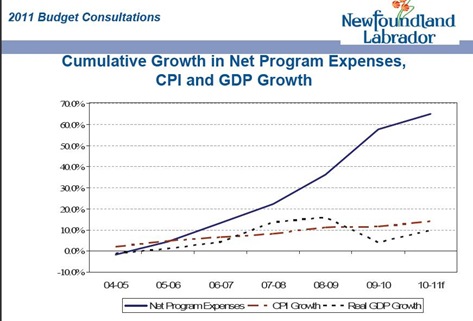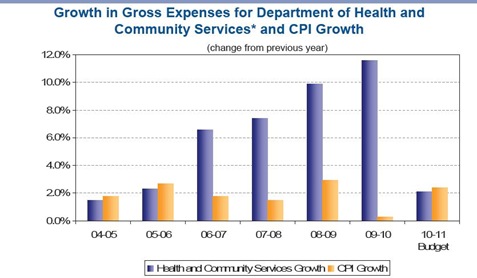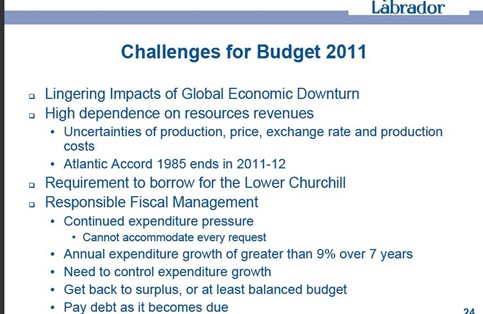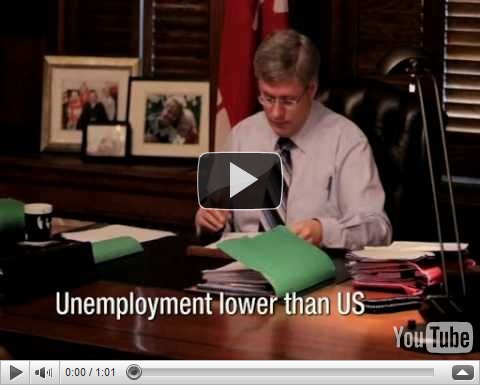For those who have lived by the provincial government’s polling as proof of how popular the governing Conservatives have been, the most recent provincial public opinion polls offer no comfort.
An NTV/Telelink poll released Wednesday [link to NTV report] shows support for the governing provincial Conservatives is currently at 44.3% with 37.9% undecided.
NTV is reporting those figures as being not much different from the last provincial government poll in November, but that’s not the case.
A straight comparison – using the Telelink approach – shows that support for the province’s Tories is down from 51.8% in the CRA poll. Undecideds in the Corporate Research Associates poll conducted last November stood at 31% on the party support question.
Danny Williams didn’t announce his resignation until the end of CRA’s polling period and it is unlikely his departure significantly changed the poll results. in other words, undecideds in November increased despite the fact Williams was still the premier at the time CRA conducted the poll.
And in case you missed the point, support for the province’s Tories has plummeted in the past six months from 61.8% to 44.3%.
While CRA polling has some very serious credibility problems, Telelink has been notoriously more accurate by comparison. Their September 2007 poll nailed the Conservative share of eligible voters smack on the money. CRA was 20 percentage points off. For those counting, CRA was out by something like 32 percent, not the margin of error cited in the poll at the time. Telelink also got within seven percentage points of the undecided/will not vote (31% polled versus 38) while CRA was basically OTL (18% polled versus 38% actual)
What’s going on? You can get a good sense of this by looking at the undecideds. Over the past 20 years or so, local polls tend to see a change in “undecideds” when people are unhappy with the incumbent party. They may not be so disgruntled that they switch to the major opposition party; they may not see the opposition as a viable alternative at that moment.
In this survey, NTV/Telelink did something CRA never does: they probed the undecideds and asked them which way they might be leaning. The Tory number climbed but the undecideds were still around 25% according to the NTV report.
That’s still pretty high and it cannot be very encouraging for the Tories.
In Newfoundland and Labrador politics, there are cadres of dedicated party voters. They turn out and vote the same way pretty well every time. But the biggest chunk of voters are swing voters. They are not ideological or overly wrapped up in one party affiliation or another and they are the prize for any party wanting power. When polling in the province changes significantly, odds are the swing voters are swinging. [new sentence added for clarity]
For those who accept CRA polls, you’d have to be worried about the change that showed up last November. This most recent change happened under Danny, the supposedly invincible. he’s gone and the slide is still there. Now the decided party support for the Tories is down again by about 18 percentage points.
Now look at the vote results in the by-elections off the Avalon since 2007. In Humber West, Tory support dropped about 24%, the largest percentage since 2003. The Liberal vote climbed by a comparable percentage for a combined swing of 45%. That’s in the heart of the Tories’ west coast base.
Remember Danny Williams’ comments right before the by-election about how good Tories have been to the entire west coast? Yeah, well here’s the payback on that investment. In the Straits, they rejected the Tory candidate altogether and the Tories retaliated or appear to have retaliated with the air ambulance move. That couldn’t have helped their overall position on the peninsula.
And in case you are wondering, the swing in Humber West was larger than the 2011 swing in the Straits and St. Barbe that heralded the rise of Danny Williams.
Take Humber West as the example of a trend. Even when the Tories win, it’s getting pretty clear that they are losing some of their voters. Some may be core Tories who are getting getting complacent. Some might be Tories who are just tired of the internal war with their federal cousins. More likely, they are losing independent or swing voters owing to nothing more radical than fatigue.
Now consider that in the face of this fairly obvious weakening of Tory support, their most recent decision is to play all-defence with virtually no change in the fundamental direction of the party. Premier Kathy Dunderdale told reporters in Corner Brook that there’s no change in the overall make-up of her administration until sometime after the fall election.
A defensive game might win.
However, that strategy depends very much on what the Liberals do. it smacks of the same sort of conventional wisdom slash complacency that led them to count on Danny being around for another one and then some. Shit happens, as they say.
If the Tories can hold it together, keep a lid on internal fractures, avoid making any controversial decisions, spend like drunken sailors and run a Humber West-style hide ‘em if ya got ‘em campaign, they might hang on to most of the seats they currently hold.
That assumes, though, that the Liberals just stumble their way along as they did in 2007. If the Liberals shift their direction just a bit a lot can change. Solid local candidates, for example, can make local races competitive in districts outside the metro St. John’s region. There are plenty of districts that went barely blue in 2007 and there are undoubtedly plenty of polls within districts that reverted – as in Terra Nova – to their former, Liberal voting patterns. It doesn’t take much to swing a poll or a district as the Tories and those familiar with the province’s long electoral history should know.
In the current political environment, small changes can produce disproportionate results. There’s more than enough time between now and October for one change or a combination of changes to produce the sort of political upheavals that happened in the last week of November and the first week of December last year.
2011 could be one of the most interesting political years in Newfoundland and Labrador history.
- srbp -












